Organisational Behaviour: Culture, Power, and Motivation at PRIMARK
VerifiedAdded on 2023/01/13
|15
|4759
|41
Report
AI Summary
This report delves into the realm of organisational behaviour, using PRIMARK, an Irish fast-fashion retailer, as a case study. It initiates with an exploration of organisational culture, examining Handy's culture model (role, power, and task cultures) and its impact on employee behaviour. Subsequently, the report analyses organisational power dynamics, including reward, coercive, and information power, and the influence of organisational politics. The core of the report evaluates motivational theories, focusing on Maslow's need hierarchy theory and Vroom's expectancy theory, to understand employee motivation within PRIMARK. The report then assesses effective and ineffective team dynamics, offering insights into teamwork and coordination. Finally, it concludes by applying philosophies of organisational behaviour to the achievement of organisational goals and objectives, offering a comprehensive overview of how these concepts shape workplace dynamics and employee performance within the context of a global retail company.
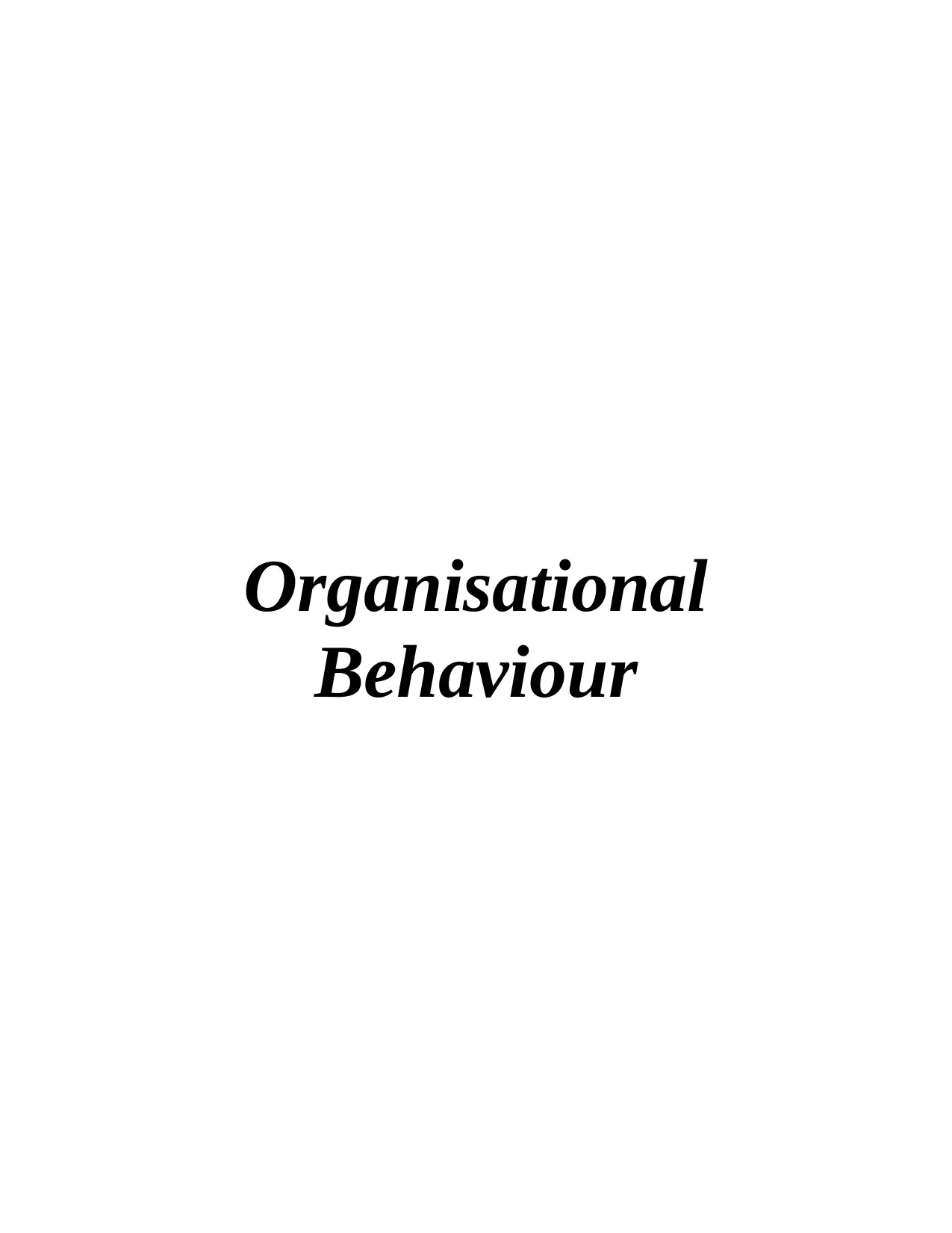
Organisational
Behaviour
Behaviour
Paraphrase This Document
Need a fresh take? Get an instant paraphrase of this document with our AI Paraphraser
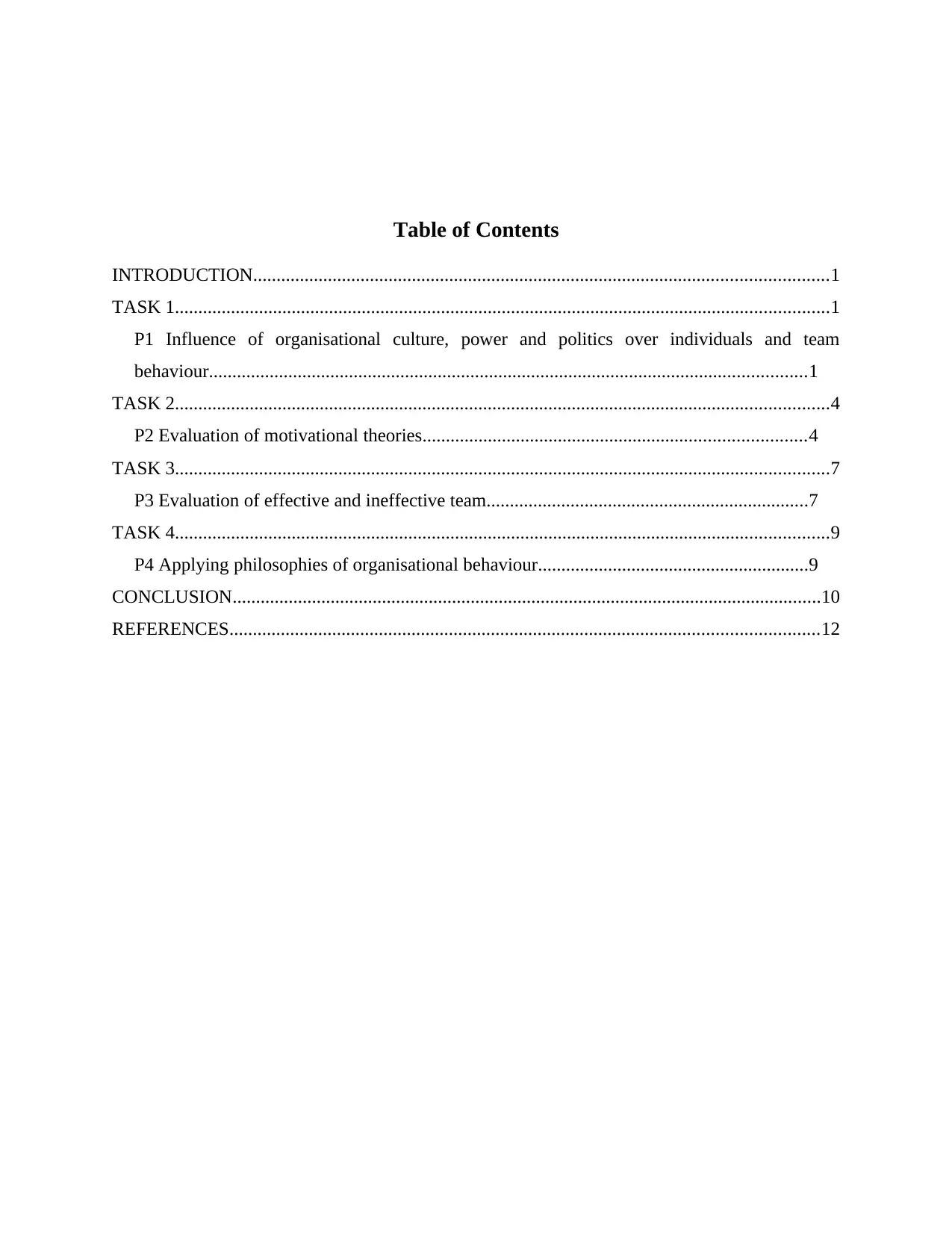
Table of Contents
INTRODUCTION...........................................................................................................................1
TASK 1............................................................................................................................................1
P1 Influence of organisational culture, power and politics over individuals and team
behaviour................................................................................................................................1
TASK 2............................................................................................................................................4
P2 Evaluation of motivational theories..................................................................................4
TASK 3............................................................................................................................................7
P3 Evaluation of effective and ineffective team.....................................................................7
TASK 4............................................................................................................................................9
P4 Applying philosophies of organisational behaviour..........................................................9
CONCLUSION..............................................................................................................................10
REFERENCES..............................................................................................................................12
INTRODUCTION...........................................................................................................................1
TASK 1............................................................................................................................................1
P1 Influence of organisational culture, power and politics over individuals and team
behaviour................................................................................................................................1
TASK 2............................................................................................................................................4
P2 Evaluation of motivational theories..................................................................................4
TASK 3............................................................................................................................................7
P3 Evaluation of effective and ineffective team.....................................................................7
TASK 4............................................................................................................................................9
P4 Applying philosophies of organisational behaviour..........................................................9
CONCLUSION..............................................................................................................................10
REFERENCES..............................................................................................................................12
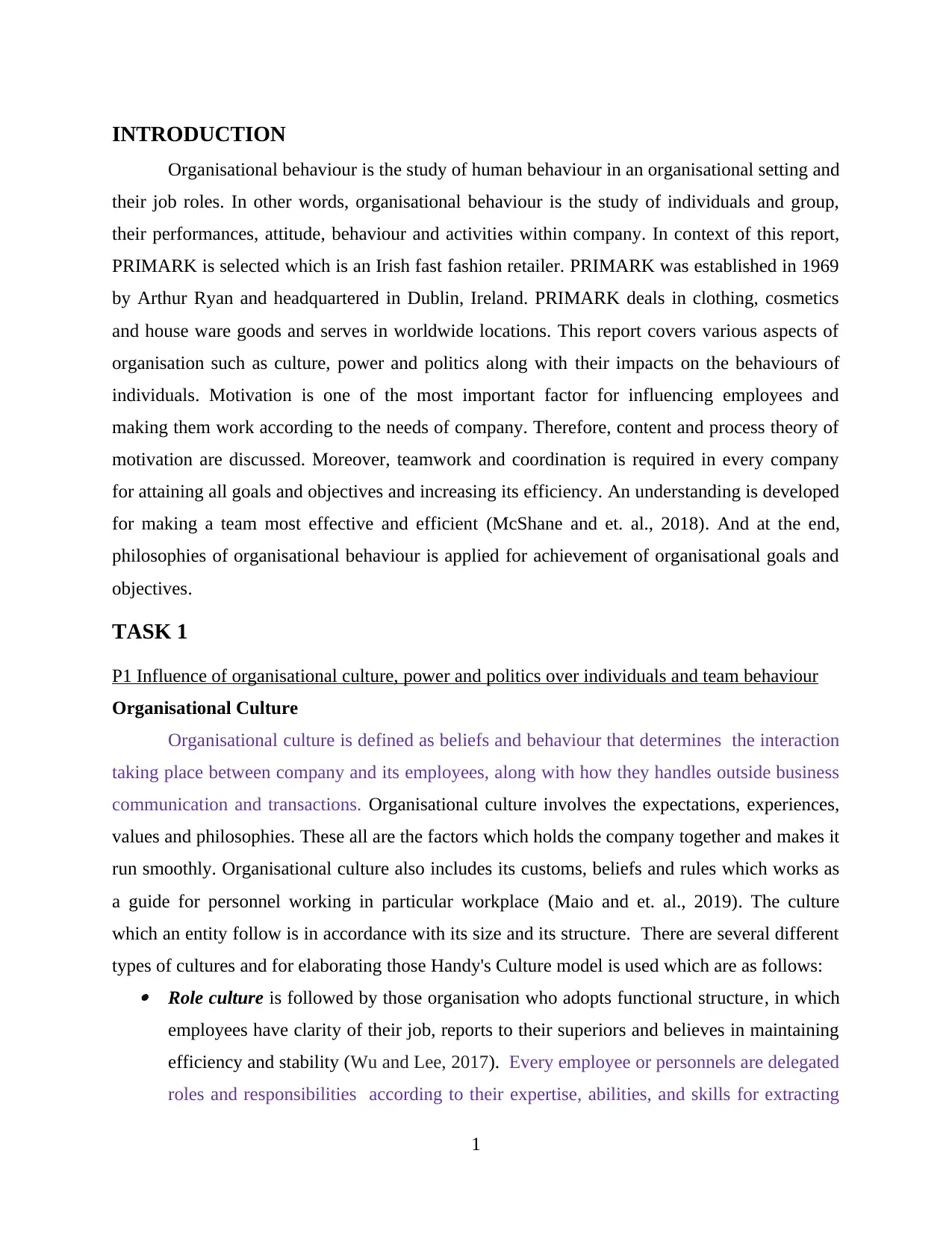
INTRODUCTION
Organisational behaviour is the study of human behaviour in an organisational setting and
their job roles. In other words, organisational behaviour is the study of individuals and group,
their performances, attitude, behaviour and activities within company. In context of this report,
PRIMARK is selected which is an Irish fast fashion retailer. PRIMARK was established in 1969
by Arthur Ryan and headquartered in Dublin, Ireland. PRIMARK deals in clothing, cosmetics
and house ware goods and serves in worldwide locations. This report covers various aspects of
organisation such as culture, power and politics along with their impacts on the behaviours of
individuals. Motivation is one of the most important factor for influencing employees and
making them work according to the needs of company. Therefore, content and process theory of
motivation are discussed. Moreover, teamwork and coordination is required in every company
for attaining all goals and objectives and increasing its efficiency. An understanding is developed
for making a team most effective and efficient (McShane and et. al., 2018). And at the end,
philosophies of organisational behaviour is applied for achievement of organisational goals and
objectives.
TASK 1
P1 Influence of organisational culture, power and politics over individuals and team behaviour
Organisational Culture
Organisational culture is defined as beliefs and behaviour that determines the interaction
taking place between company and its employees, along with how they handles outside business
communication and transactions. Organisational culture involves the expectations, experiences,
values and philosophies. These all are the factors which holds the company together and makes it
run smoothly. Organisational culture also includes its customs, beliefs and rules which works as
a guide for personnel working in particular workplace (Maio and et. al., 2019). The culture
which an entity follow is in accordance with its size and its structure. There are several different
types of cultures and for elaborating those Handy's Culture model is used which are as follows: Role culture is followed by those organisation who adopts functional structure, in which
employees have clarity of their job, reports to their superiors and believes in maintaining
efficiency and stability (Wu and Lee, 2017). Every employee or personnels are delegated
roles and responsibilities according to their expertise, abilities, and skills for extracting
1
Organisational behaviour is the study of human behaviour in an organisational setting and
their job roles. In other words, organisational behaviour is the study of individuals and group,
their performances, attitude, behaviour and activities within company. In context of this report,
PRIMARK is selected which is an Irish fast fashion retailer. PRIMARK was established in 1969
by Arthur Ryan and headquartered in Dublin, Ireland. PRIMARK deals in clothing, cosmetics
and house ware goods and serves in worldwide locations. This report covers various aspects of
organisation such as culture, power and politics along with their impacts on the behaviours of
individuals. Motivation is one of the most important factor for influencing employees and
making them work according to the needs of company. Therefore, content and process theory of
motivation are discussed. Moreover, teamwork and coordination is required in every company
for attaining all goals and objectives and increasing its efficiency. An understanding is developed
for making a team most effective and efficient (McShane and et. al., 2018). And at the end,
philosophies of organisational behaviour is applied for achievement of organisational goals and
objectives.
TASK 1
P1 Influence of organisational culture, power and politics over individuals and team behaviour
Organisational Culture
Organisational culture is defined as beliefs and behaviour that determines the interaction
taking place between company and its employees, along with how they handles outside business
communication and transactions. Organisational culture involves the expectations, experiences,
values and philosophies. These all are the factors which holds the company together and makes it
run smoothly. Organisational culture also includes its customs, beliefs and rules which works as
a guide for personnel working in particular workplace (Maio and et. al., 2019). The culture
which an entity follow is in accordance with its size and its structure. There are several different
types of cultures and for elaborating those Handy's Culture model is used which are as follows: Role culture is followed by those organisation who adopts functional structure, in which
employees have clarity of their job, reports to their superiors and believes in maintaining
efficiency and stability (Wu and Lee, 2017). Every employee or personnels are delegated
roles and responsibilities according to their expertise, abilities, and skills for extracting
1
⊘ This is a preview!⊘
Do you want full access?
Subscribe today to unlock all pages.

Trusted by 1+ million students worldwide
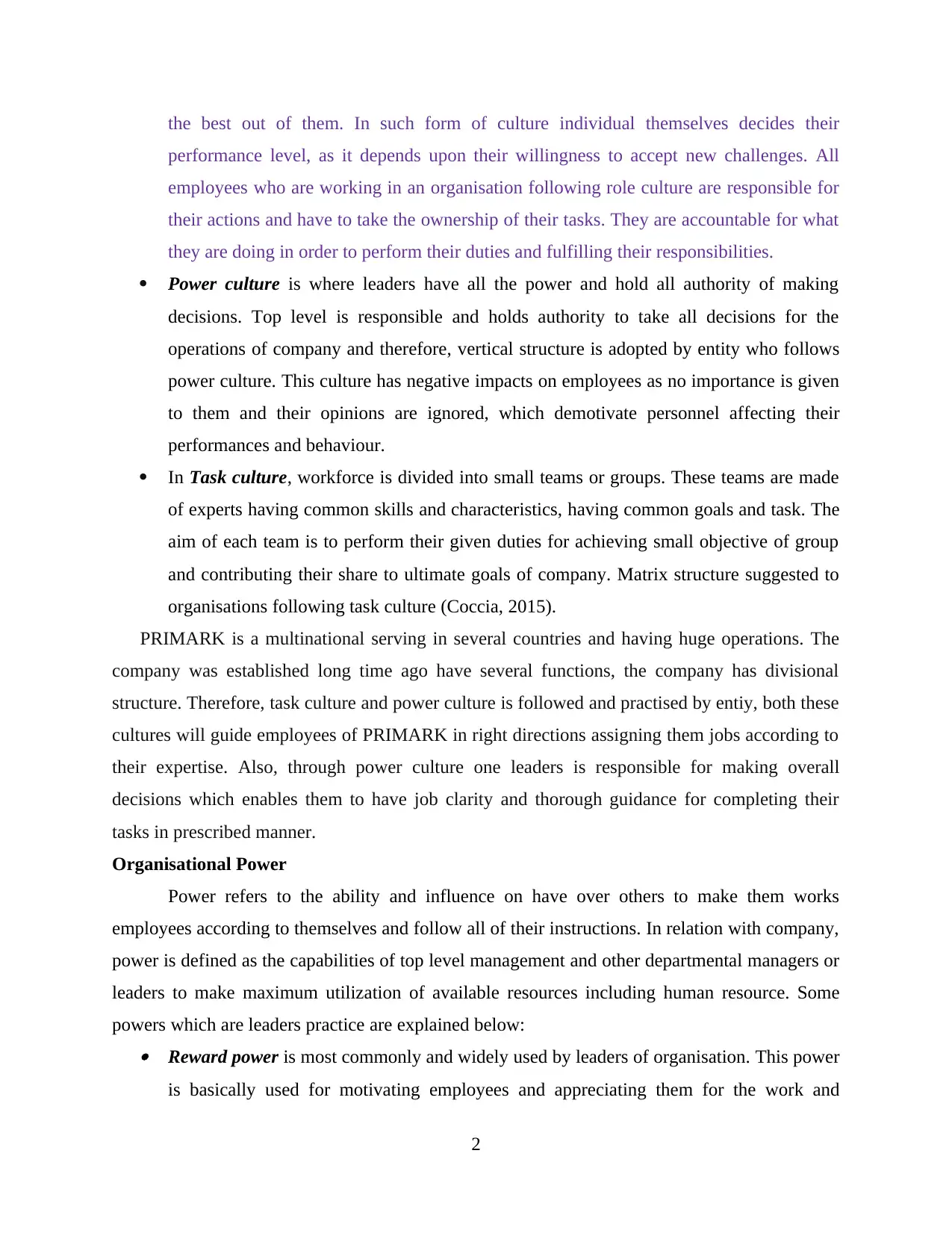
the best out of them. In such form of culture individual themselves decides their
performance level, as it depends upon their willingness to accept new challenges. All
employees who are working in an organisation following role culture are responsible for
their actions and have to take the ownership of their tasks. They are accountable for what
they are doing in order to perform their duties and fulfilling their responsibilities.
Power culture is where leaders have all the power and hold all authority of making
decisions. Top level is responsible and holds authority to take all decisions for the
operations of company and therefore, vertical structure is adopted by entity who follows
power culture. This culture has negative impacts on employees as no importance is given
to them and their opinions are ignored, which demotivate personnel affecting their
performances and behaviour.
In Task culture, workforce is divided into small teams or groups. These teams are made
of experts having common skills and characteristics, having common goals and task. The
aim of each team is to perform their given duties for achieving small objective of group
and contributing their share to ultimate goals of company. Matrix structure suggested to
organisations following task culture (Coccia, 2015).
PRIMARK is a multinational serving in several countries and having huge operations. The
company was established long time ago have several functions, the company has divisional
structure. Therefore, task culture and power culture is followed and practised by entiy, both these
cultures will guide employees of PRIMARK in right directions assigning them jobs according to
their expertise. Also, through power culture one leaders is responsible for making overall
decisions which enables them to have job clarity and thorough guidance for completing their
tasks in prescribed manner.
Organisational Power
Power refers to the ability and influence on have over others to make them works
employees according to themselves and follow all of their instructions. In relation with company,
power is defined as the capabilities of top level management and other departmental managers or
leaders to make maximum utilization of available resources including human resource. Some
powers which are leaders practice are explained below: Reward power is most commonly and widely used by leaders of organisation. This power
is basically used for motivating employees and appreciating them for the work and
2
performance level, as it depends upon their willingness to accept new challenges. All
employees who are working in an organisation following role culture are responsible for
their actions and have to take the ownership of their tasks. They are accountable for what
they are doing in order to perform their duties and fulfilling their responsibilities.
Power culture is where leaders have all the power and hold all authority of making
decisions. Top level is responsible and holds authority to take all decisions for the
operations of company and therefore, vertical structure is adopted by entity who follows
power culture. This culture has negative impacts on employees as no importance is given
to them and their opinions are ignored, which demotivate personnel affecting their
performances and behaviour.
In Task culture, workforce is divided into small teams or groups. These teams are made
of experts having common skills and characteristics, having common goals and task. The
aim of each team is to perform their given duties for achieving small objective of group
and contributing their share to ultimate goals of company. Matrix structure suggested to
organisations following task culture (Coccia, 2015).
PRIMARK is a multinational serving in several countries and having huge operations. The
company was established long time ago have several functions, the company has divisional
structure. Therefore, task culture and power culture is followed and practised by entiy, both these
cultures will guide employees of PRIMARK in right directions assigning them jobs according to
their expertise. Also, through power culture one leaders is responsible for making overall
decisions which enables them to have job clarity and thorough guidance for completing their
tasks in prescribed manner.
Organisational Power
Power refers to the ability and influence on have over others to make them works
employees according to themselves and follow all of their instructions. In relation with company,
power is defined as the capabilities of top level management and other departmental managers or
leaders to make maximum utilization of available resources including human resource. Some
powers which are leaders practice are explained below: Reward power is most commonly and widely used by leaders of organisation. This power
is basically used for motivating employees and appreciating them for the work and
2
Paraphrase This Document
Need a fresh take? Get an instant paraphrase of this document with our AI Paraphraser
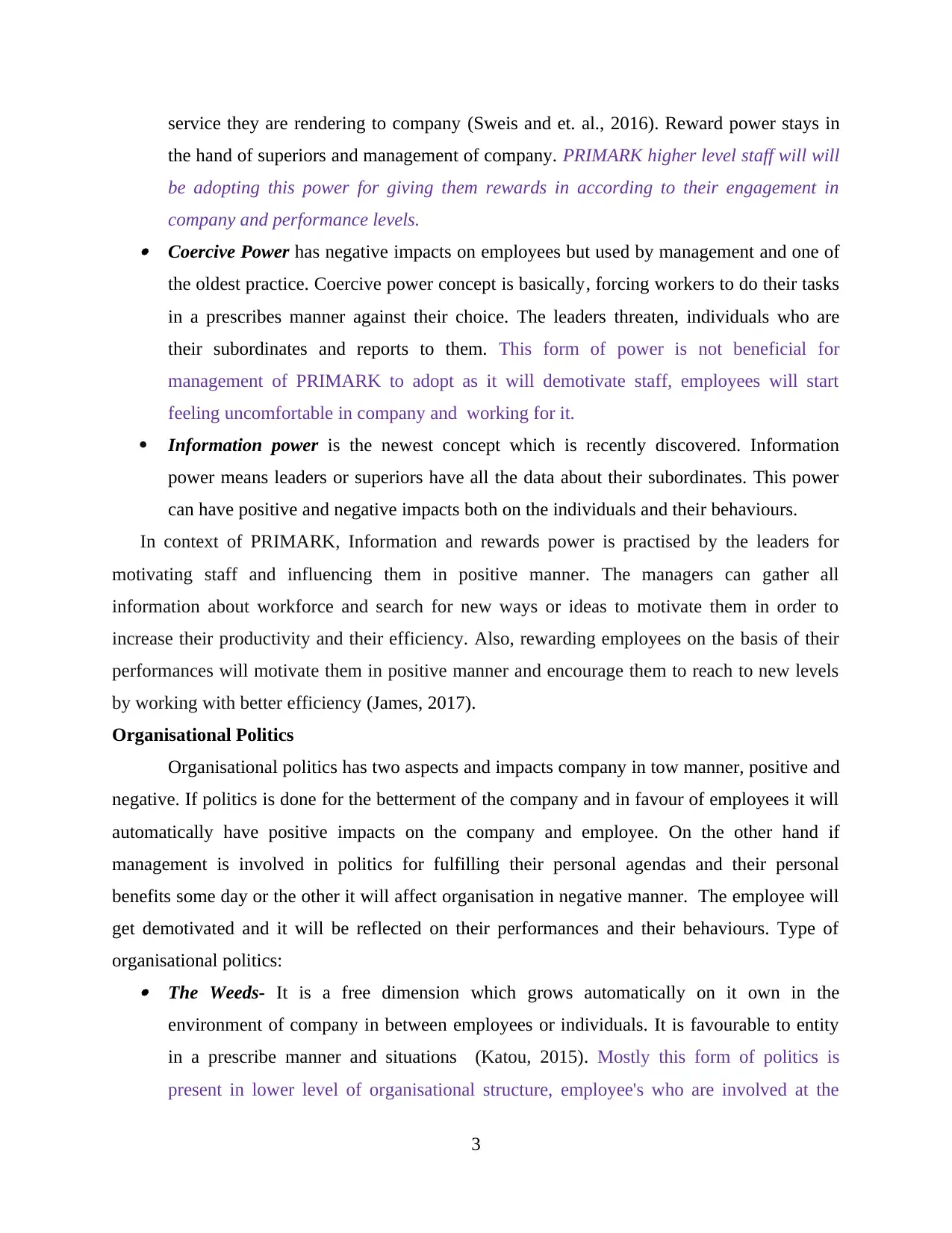
service they are rendering to company (Sweis and et. al., 2016). Reward power stays in
the hand of superiors and management of company. PRIMARK higher level staff will will
be adopting this power for giving them rewards in according to their engagement in
company and performance levels. Coercive Power has negative impacts on employees but used by management and one of
the oldest practice. Coercive power concept is basically, forcing workers to do their tasks
in a prescribes manner against their choice. The leaders threaten, individuals who are
their subordinates and reports to them. This form of power is not beneficial for
management of PRIMARK to adopt as it will demotivate staff, employees will start
feeling uncomfortable in company and working for it.
Information power is the newest concept which is recently discovered. Information
power means leaders or superiors have all the data about their subordinates. This power
can have positive and negative impacts both on the individuals and their behaviours.
In context of PRIMARK, Information and rewards power is practised by the leaders for
motivating staff and influencing them in positive manner. The managers can gather all
information about workforce and search for new ways or ideas to motivate them in order to
increase their productivity and their efficiency. Also, rewarding employees on the basis of their
performances will motivate them in positive manner and encourage them to reach to new levels
by working with better efficiency (James, 2017).
Organisational Politics
Organisational politics has two aspects and impacts company in tow manner, positive and
negative. If politics is done for the betterment of the company and in favour of employees it will
automatically have positive impacts on the company and employee. On the other hand if
management is involved in politics for fulfilling their personal agendas and their personal
benefits some day or the other it will affect organisation in negative manner. The employee will
get demotivated and it will be reflected on their performances and their behaviours. Type of
organisational politics: The Weeds- It is a free dimension which grows automatically on it own in the
environment of company in between employees or individuals. It is favourable to entity
in a prescribe manner and situations (Katou, 2015). Mostly this form of politics is
present in lower level of organisational structure, employee's who are involved at the
3
the hand of superiors and management of company. PRIMARK higher level staff will will
be adopting this power for giving them rewards in according to their engagement in
company and performance levels. Coercive Power has negative impacts on employees but used by management and one of
the oldest practice. Coercive power concept is basically, forcing workers to do their tasks
in a prescribes manner against their choice. The leaders threaten, individuals who are
their subordinates and reports to them. This form of power is not beneficial for
management of PRIMARK to adopt as it will demotivate staff, employees will start
feeling uncomfortable in company and working for it.
Information power is the newest concept which is recently discovered. Information
power means leaders or superiors have all the data about their subordinates. This power
can have positive and negative impacts both on the individuals and their behaviours.
In context of PRIMARK, Information and rewards power is practised by the leaders for
motivating staff and influencing them in positive manner. The managers can gather all
information about workforce and search for new ways or ideas to motivate them in order to
increase their productivity and their efficiency. Also, rewarding employees on the basis of their
performances will motivate them in positive manner and encourage them to reach to new levels
by working with better efficiency (James, 2017).
Organisational Politics
Organisational politics has two aspects and impacts company in tow manner, positive and
negative. If politics is done for the betterment of the company and in favour of employees it will
automatically have positive impacts on the company and employee. On the other hand if
management is involved in politics for fulfilling their personal agendas and their personal
benefits some day or the other it will affect organisation in negative manner. The employee will
get demotivated and it will be reflected on their performances and their behaviours. Type of
organisational politics: The Weeds- It is a free dimension which grows automatically on it own in the
environment of company in between employees or individuals. It is favourable to entity
in a prescribe manner and situations (Katou, 2015). Mostly this form of politics is
present in lower level of organisational structure, employee's who are involved at the
3
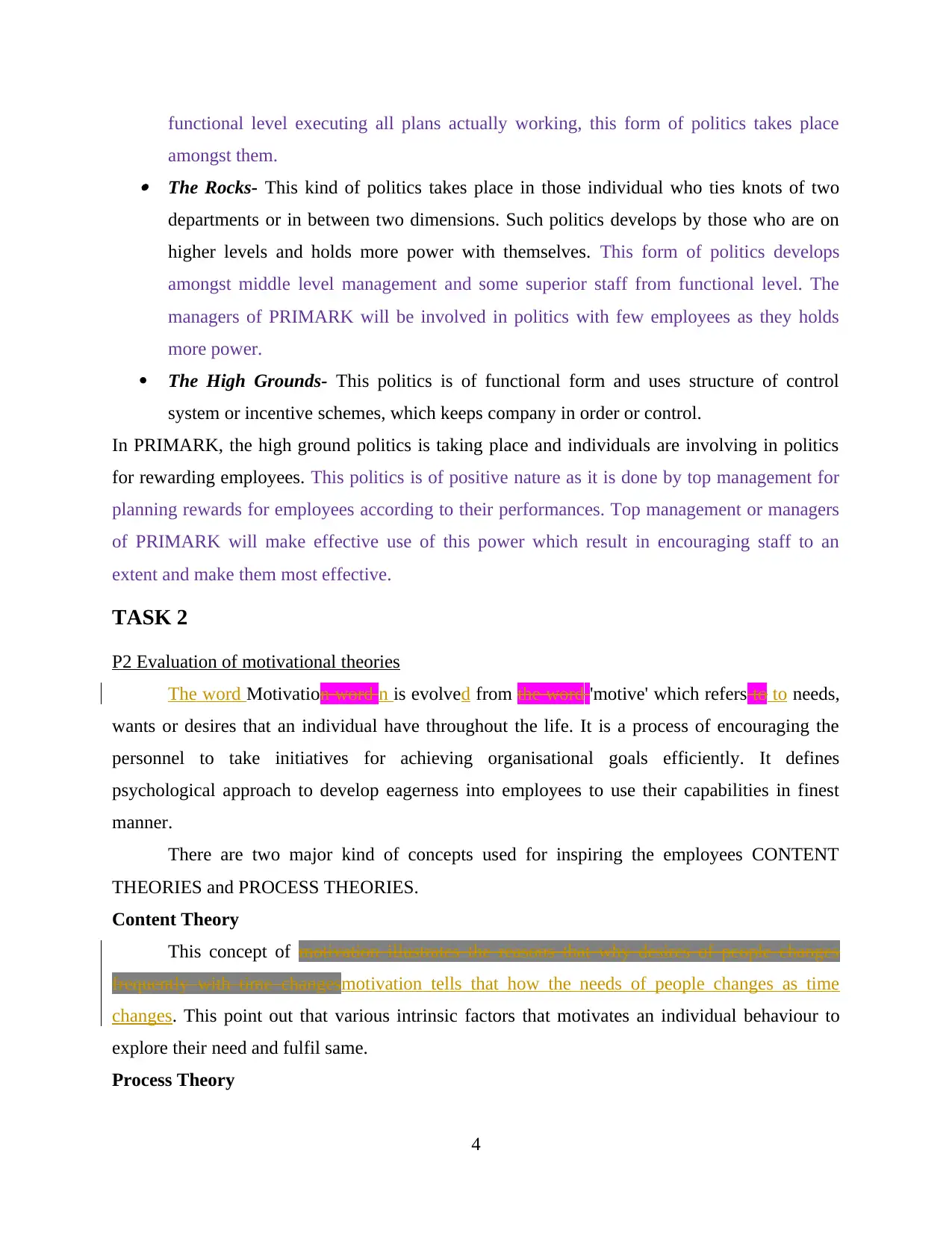
functional level executing all plans actually working, this form of politics takes place
amongst them. The Rocks- This kind of politics takes place in those individual who ties knots of two
departments or in between two dimensions. Such politics develops by those who are on
higher levels and holds more power with themselves. This form of politics develops
amongst middle level management and some superior staff from functional level. The
managers of PRIMARK will be involved in politics with few employees as they holds
more power.
The High Grounds- This politics is of functional form and uses structure of control
system or incentive schemes, which keeps company in order or control.
In PRIMARK, the high ground politics is taking place and individuals are involving in politics
for rewarding employees. This politics is of positive nature as it is done by top management for
planning rewards for employees according to their performances. Top management or managers
of PRIMARK will make effective use of this power which result in encouraging staff to an
extent and make them most effective.
TASK 2
P2 Evaluation of motivational theories
The word Motivation word n is evolved from the word 'motive' which refers to to needs,
wants or desires that an individual have throughout the life. It is a process of encouraging the
personnel to take initiatives for achieving organisational goals efficiently. It defines
psychological approach to develop eagerness into employees to use their capabilities in finest
manner.
There are two major kind of concepts used for inspiring the employees CONTENT
THEORIES and PROCESS THEORIES.
Content Theory
This concept of motivation illustrates the reasons that why desires of people changes
frequently with time changesmotivation tells that how the needs of people changes as time
changes. This point out that various intrinsic factors that motivates an individual behaviour to
explore their need and fulfil same.
Process Theory
4
amongst them. The Rocks- This kind of politics takes place in those individual who ties knots of two
departments or in between two dimensions. Such politics develops by those who are on
higher levels and holds more power with themselves. This form of politics develops
amongst middle level management and some superior staff from functional level. The
managers of PRIMARK will be involved in politics with few employees as they holds
more power.
The High Grounds- This politics is of functional form and uses structure of control
system or incentive schemes, which keeps company in order or control.
In PRIMARK, the high ground politics is taking place and individuals are involving in politics
for rewarding employees. This politics is of positive nature as it is done by top management for
planning rewards for employees according to their performances. Top management or managers
of PRIMARK will make effective use of this power which result in encouraging staff to an
extent and make them most effective.
TASK 2
P2 Evaluation of motivational theories
The word Motivation word n is evolved from the word 'motive' which refers to to needs,
wants or desires that an individual have throughout the life. It is a process of encouraging the
personnel to take initiatives for achieving organisational goals efficiently. It defines
psychological approach to develop eagerness into employees to use their capabilities in finest
manner.
There are two major kind of concepts used for inspiring the employees CONTENT
THEORIES and PROCESS THEORIES.
Content Theory
This concept of motivation illustrates the reasons that why desires of people changes
frequently with time changesmotivation tells that how the needs of people changes as time
changes. This point out that various intrinsic factors that motivates an individual behaviour to
explore their need and fulfil same.
Process Theory
4
⊘ This is a preview!⊘
Do you want full access?
Subscribe today to unlock all pages.

Trusted by 1+ million students worldwide
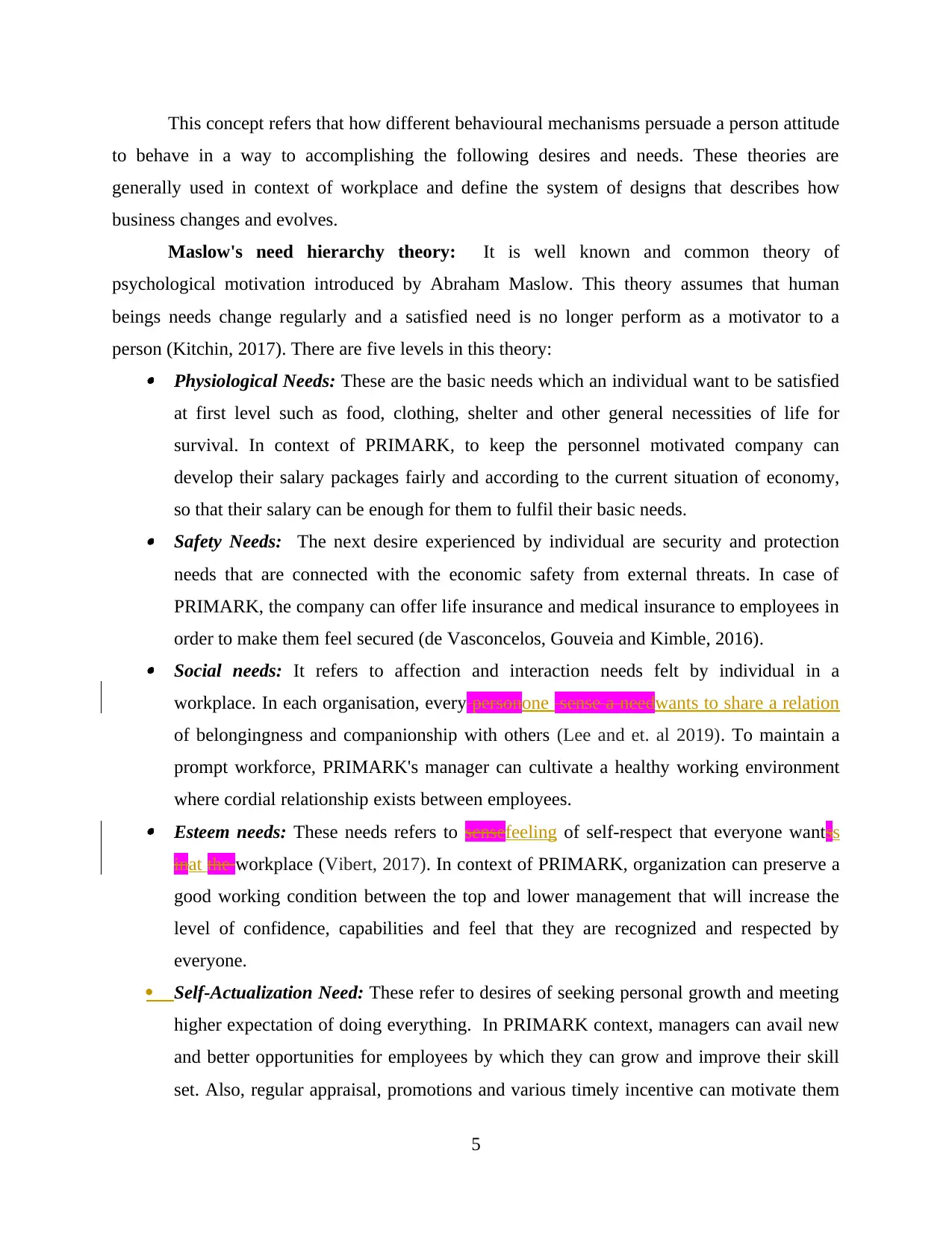
This concept refers that how different behavioural mechanisms persuade a person attitude
to behave in a way to accomplishing the following desires and needs. These theories are
generally used in context of workplace and define the system of designs that describes how
business changes and evolves.
Maslow's need hierarchy theory: It is well known and common theory of
psychological motivation introduced by Abraham Maslow. This theory assumes that human
beings needs change regularly and a satisfied need is no longer perform as a motivator to a
person (Kitchin, 2017). There are five levels in this theory: Physiological Needs: These are the basic needs which an individual want to be satisfied
at first level such as food, clothing, shelter and other general necessities of life for
survival. In context of PRIMARK, to keep the personnel motivated company can
develop their salary packages fairly and according to the current situation of economy,
so that their salary can be enough for them to fulfil their basic needs. Safety Needs: The next desire experienced by individual are security and protection
needs that are connected with the economic safety from external threats. In case of
PRIMARK, the company can offer life insurance and medical insurance to employees in
order to make them feel secured (de Vasconcelos, Gouveia and Kimble, 2016). Social needs: It refers to affection and interaction needs felt by individual in a
workplace. In each organisation, every personone sense a needwants to share a relation
of belongingness and companionship with others (Lee and et. al 2019). To maintain a
prompt workforce, PRIMARK's manager can cultivate a healthy working environment
where cordial relationship exists between employees. Esteem needs: These needs refers to sensefeeling of self-respect that everyone wantss
inat the workplace (Vibert, 2017). In context of PRIMARK, organization can preserve a
good working condition between the top and lower management that will increase the
level of confidence, capabilities and feel that they are recognized and respected by
everyone.
Self-Actualization Need: These refer to desires of seeking personal growth and meeting
higher expectation of doing everything. In PRIMARK context, managers can avail new
and better opportunities for employees by which they can grow and improve their skill
set. Also, regular appraisal, promotions and various timely incentive can motivate them
5
to behave in a way to accomplishing the following desires and needs. These theories are
generally used in context of workplace and define the system of designs that describes how
business changes and evolves.
Maslow's need hierarchy theory: It is well known and common theory of
psychological motivation introduced by Abraham Maslow. This theory assumes that human
beings needs change regularly and a satisfied need is no longer perform as a motivator to a
person (Kitchin, 2017). There are five levels in this theory: Physiological Needs: These are the basic needs which an individual want to be satisfied
at first level such as food, clothing, shelter and other general necessities of life for
survival. In context of PRIMARK, to keep the personnel motivated company can
develop their salary packages fairly and according to the current situation of economy,
so that their salary can be enough for them to fulfil their basic needs. Safety Needs: The next desire experienced by individual are security and protection
needs that are connected with the economic safety from external threats. In case of
PRIMARK, the company can offer life insurance and medical insurance to employees in
order to make them feel secured (de Vasconcelos, Gouveia and Kimble, 2016). Social needs: It refers to affection and interaction needs felt by individual in a
workplace. In each organisation, every personone sense a needwants to share a relation
of belongingness and companionship with others (Lee and et. al 2019). To maintain a
prompt workforce, PRIMARK's manager can cultivate a healthy working environment
where cordial relationship exists between employees. Esteem needs: These needs refers to sensefeeling of self-respect that everyone wantss
inat the workplace (Vibert, 2017). In context of PRIMARK, organization can preserve a
good working condition between the top and lower management that will increase the
level of confidence, capabilities and feel that they are recognized and respected by
everyone.
Self-Actualization Need: These refer to desires of seeking personal growth and meeting
higher expectation of doing everything. In PRIMARK context, managers can avail new
and better opportunities for employees by which they can grow and improve their skill
set. Also, regular appraisal, promotions and various timely incentive can motivate them
5
Paraphrase This Document
Need a fresh take? Get an instant paraphrase of this document with our AI Paraphraser
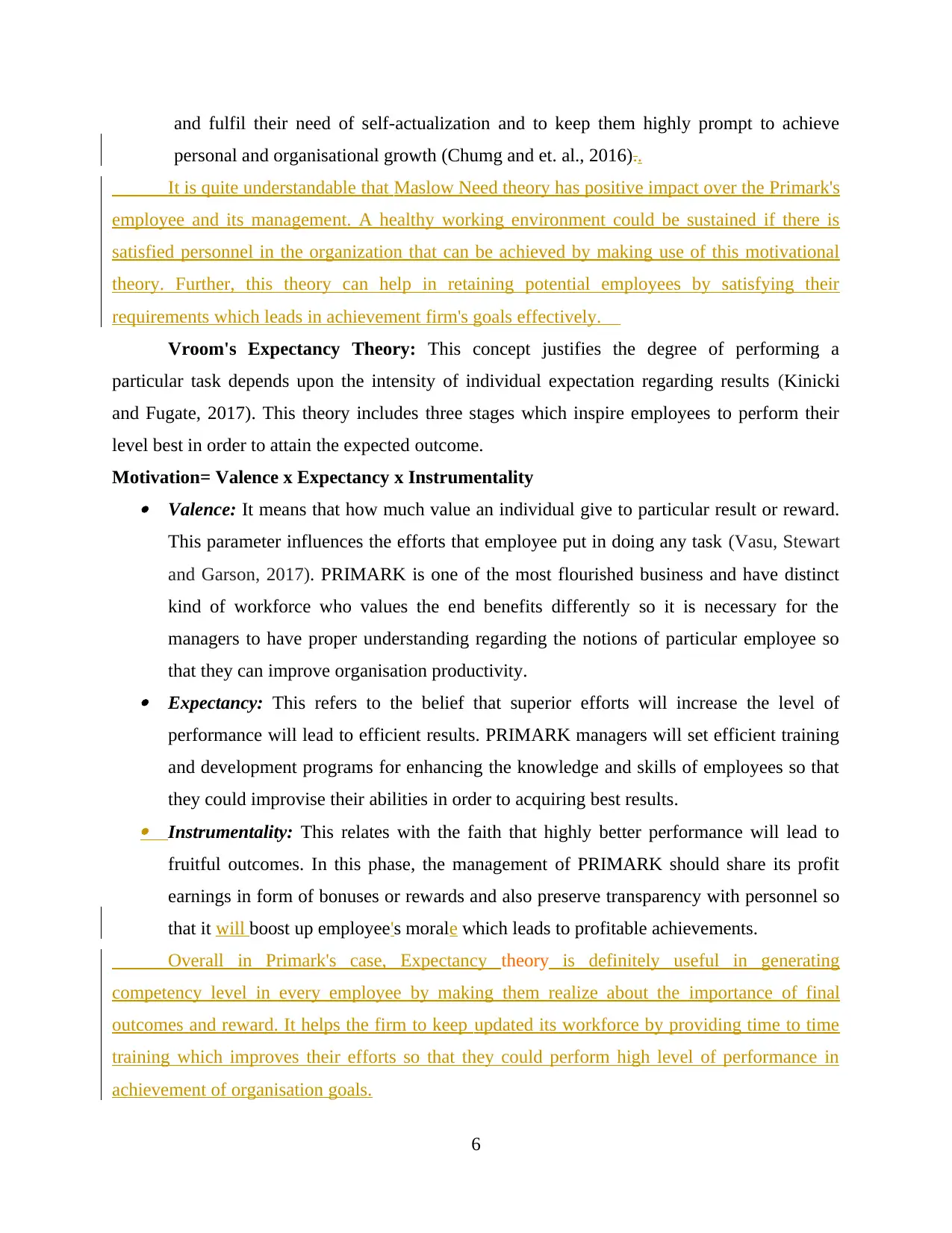
and fulfil their need of self-actualization and to keep them highly prompt to achieve
personal and organisational growth (Chumg and et. al., 2016)..
It is quite understandable that Maslow Need theory has positive impact over the Primark's
employee and its management. A healthy working environment could be sustained if there is
satisfied personnel in the organization that can be achieved by making use of this motivational
theory. Further, this theory can help in retaining potential employees by satisfying their
requirements which leads in achievement firm's goals effectively.
Vroom's Expectancy Theory: This concept justifies the degree of performing a
particular task depends upon the intensity of individual expectation regarding results (Kinicki
and Fugate, 2017). This theory includes three stages which inspire employees to perform their
level best in order to attain the expected outcome.
Motivation= Valence x Expectancy x Instrumentality Valence: It means that how much value an individual give to particular result or reward.
This parameter influences the efforts that employee put in doing any task (Vasu, Stewart
and Garson, 2017). PRIMARK is one of the most flourished business and have distinct
kind of workforce who values the end benefits differently so it is necessary for the
managers to have proper understanding regarding the notions of particular employee so
that they can improve organisation productivity. Expectancy: This refers to the belief that superior efforts will increase the level of
performance will lead to efficient results. PRIMARK managers will set efficient training
and development programs for enhancing the knowledge and skills of employees so that
they could improvise their abilities in order to acquiring best results. Instrumentality: This relates with the faith that highly better performance will lead to
fruitful outcomes. In this phase, the management of PRIMARK should share its profit
earnings in form of bonuses or rewards and also preserve transparency with personnel so
that it will boost up employee's morale which leads to profitable achievements.
Overall in Primark's case, Expectancy theory is definitely useful in generating
competency level in every employee by making them realize about the importance of final
outcomes and reward. It helps the firm to keep updated its workforce by providing time to time
training which improves their efforts so that they could perform high level of performance in
achievement of organisation goals.
6
personal and organisational growth (Chumg and et. al., 2016)..
It is quite understandable that Maslow Need theory has positive impact over the Primark's
employee and its management. A healthy working environment could be sustained if there is
satisfied personnel in the organization that can be achieved by making use of this motivational
theory. Further, this theory can help in retaining potential employees by satisfying their
requirements which leads in achievement firm's goals effectively.
Vroom's Expectancy Theory: This concept justifies the degree of performing a
particular task depends upon the intensity of individual expectation regarding results (Kinicki
and Fugate, 2017). This theory includes three stages which inspire employees to perform their
level best in order to attain the expected outcome.
Motivation= Valence x Expectancy x Instrumentality Valence: It means that how much value an individual give to particular result or reward.
This parameter influences the efforts that employee put in doing any task (Vasu, Stewart
and Garson, 2017). PRIMARK is one of the most flourished business and have distinct
kind of workforce who values the end benefits differently so it is necessary for the
managers to have proper understanding regarding the notions of particular employee so
that they can improve organisation productivity. Expectancy: This refers to the belief that superior efforts will increase the level of
performance will lead to efficient results. PRIMARK managers will set efficient training
and development programs for enhancing the knowledge and skills of employees so that
they could improvise their abilities in order to acquiring best results. Instrumentality: This relates with the faith that highly better performance will lead to
fruitful outcomes. In this phase, the management of PRIMARK should share its profit
earnings in form of bonuses or rewards and also preserve transparency with personnel so
that it will boost up employee's morale which leads to profitable achievements.
Overall in Primark's case, Expectancy theory is definitely useful in generating
competency level in every employee by making them realize about the importance of final
outcomes and reward. It helps the firm to keep updated its workforce by providing time to time
training which improves their efforts so that they could perform high level of performance in
achievement of organisation goals.
6
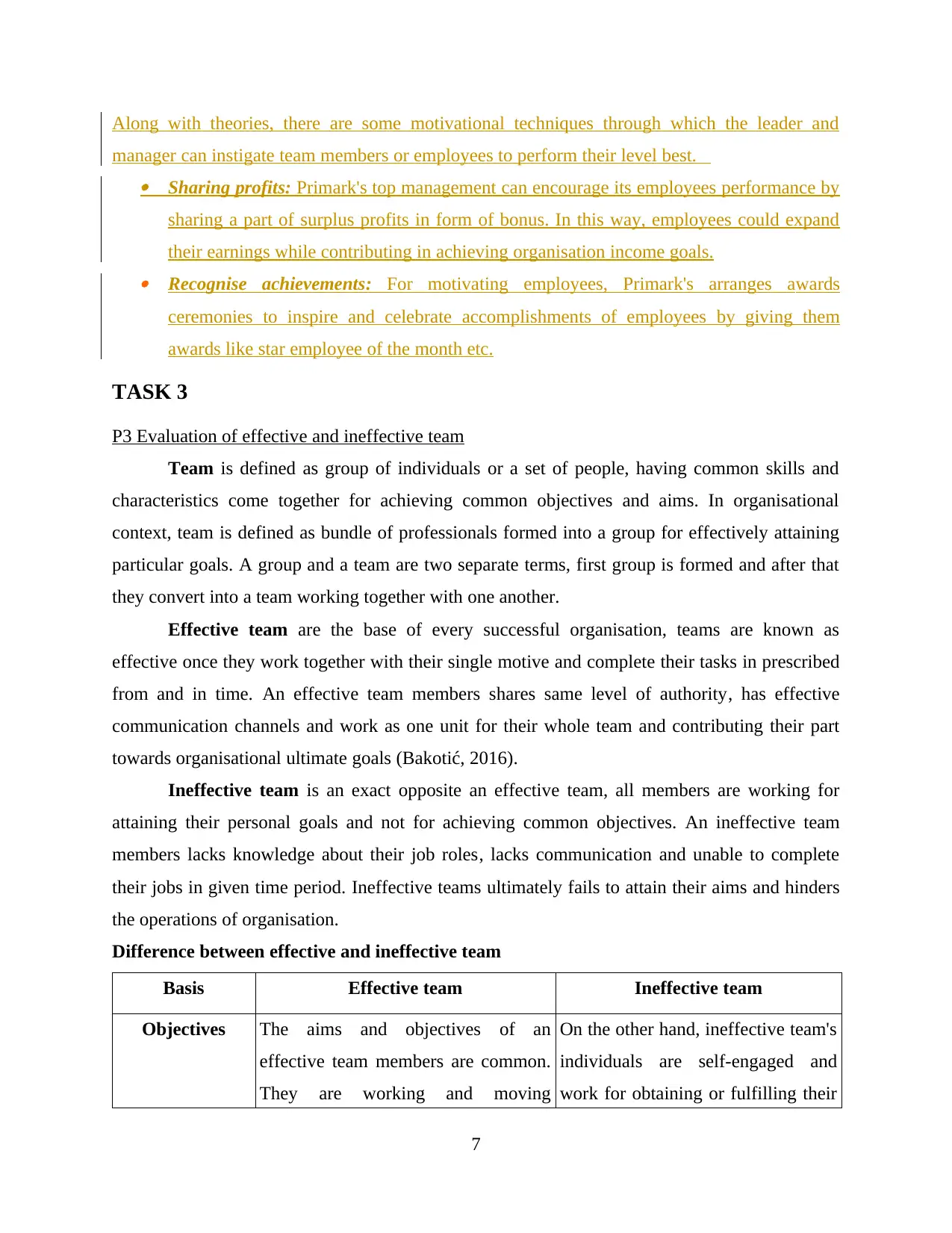
Along with theories, there are some motivational techniques through which the leader and
manager can instigate team members or employees to perform their level best. Sharing profits: Primark's top management can encourage its employees performance by
sharing a part of surplus profits in form of bonus. In this way, employees could expand
their earnings while contributing in achieving organisation income goals. Recognise achievements: For motivating employees, Primark's arranges awards
ceremonies to inspire and celebrate accomplishments of employees by giving them
awards like star employee of the month etc.
TASK 3
P3 Evaluation of effective and ineffective team
Team is defined as group of individuals or a set of people, having common skills and
characteristics come together for achieving common objectives and aims. In organisational
context, team is defined as bundle of professionals formed into a group for effectively attaining
particular goals. A group and a team are two separate terms, first group is formed and after that
they convert into a team working together with one another.
Effective team are the base of every successful organisation, teams are known as
effective once they work together with their single motive and complete their tasks in prescribed
from and in time. An effective team members shares same level of authority, has effective
communication channels and work as one unit for their whole team and contributing their part
towards organisational ultimate goals (Bakotić, 2016).
Ineffective team is an exact opposite an effective team, all members are working for
attaining their personal goals and not for achieving common objectives. An ineffective team
members lacks knowledge about their job roles, lacks communication and unable to complete
their jobs in given time period. Ineffective teams ultimately fails to attain their aims and hinders
the operations of organisation.
Difference between effective and ineffective team
Basis Effective team Ineffective team
Objectives The aims and objectives of an
effective team members are common.
They are working and moving
On the other hand, ineffective team's
individuals are self-engaged and
work for obtaining or fulfilling their
7
manager can instigate team members or employees to perform their level best. Sharing profits: Primark's top management can encourage its employees performance by
sharing a part of surplus profits in form of bonus. In this way, employees could expand
their earnings while contributing in achieving organisation income goals. Recognise achievements: For motivating employees, Primark's arranges awards
ceremonies to inspire and celebrate accomplishments of employees by giving them
awards like star employee of the month etc.
TASK 3
P3 Evaluation of effective and ineffective team
Team is defined as group of individuals or a set of people, having common skills and
characteristics come together for achieving common objectives and aims. In organisational
context, team is defined as bundle of professionals formed into a group for effectively attaining
particular goals. A group and a team are two separate terms, first group is formed and after that
they convert into a team working together with one another.
Effective team are the base of every successful organisation, teams are known as
effective once they work together with their single motive and complete their tasks in prescribed
from and in time. An effective team members shares same level of authority, has effective
communication channels and work as one unit for their whole team and contributing their part
towards organisational ultimate goals (Bakotić, 2016).
Ineffective team is an exact opposite an effective team, all members are working for
attaining their personal goals and not for achieving common objectives. An ineffective team
members lacks knowledge about their job roles, lacks communication and unable to complete
their jobs in given time period. Ineffective teams ultimately fails to attain their aims and hinders
the operations of organisation.
Difference between effective and ineffective team
Basis Effective team Ineffective team
Objectives The aims and objectives of an
effective team members are common.
They are working and moving
On the other hand, ineffective team's
individuals are self-engaged and
work for obtaining or fulfilling their
7
⊘ This is a preview!⊘
Do you want full access?
Subscribe today to unlock all pages.

Trusted by 1+ million students worldwide
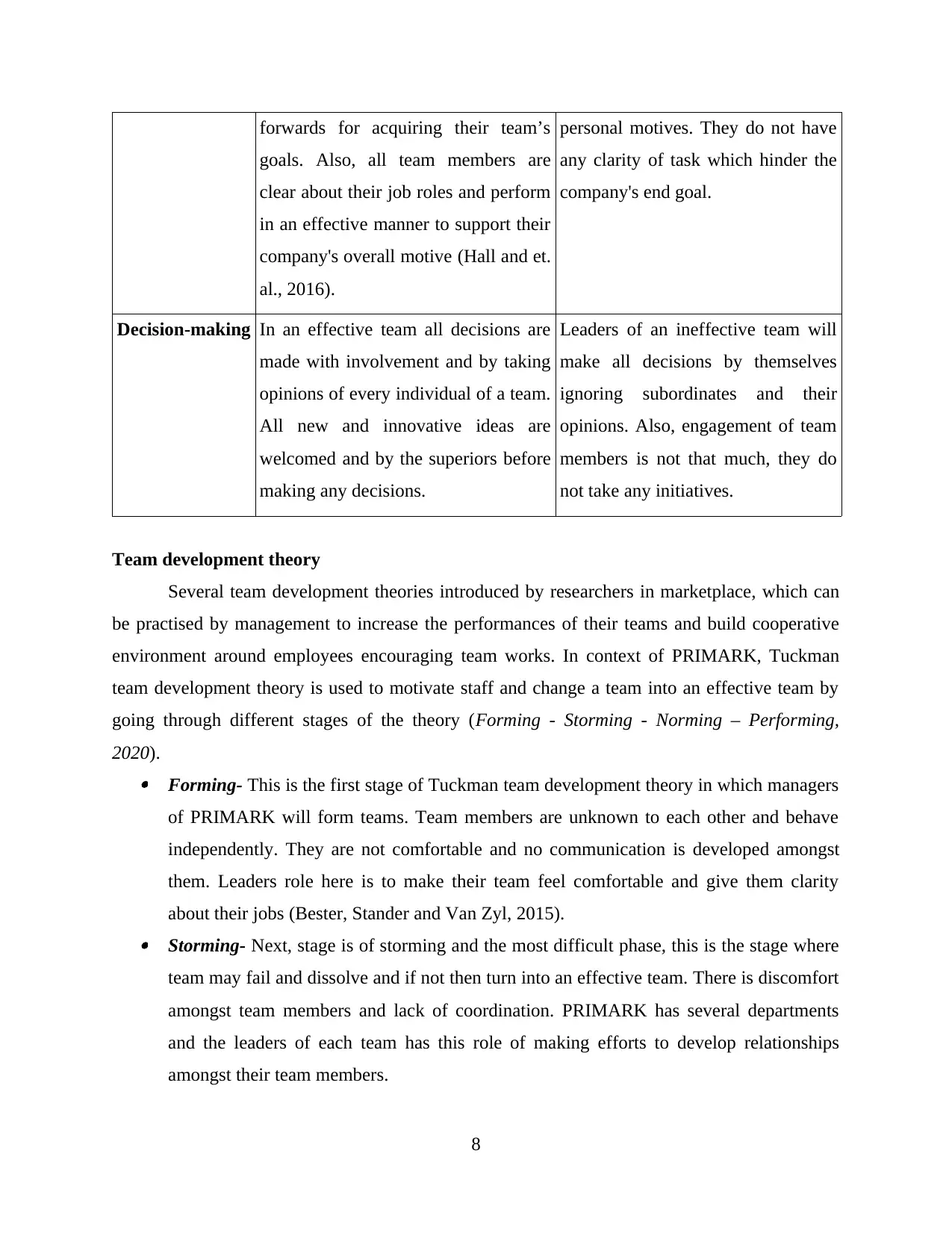
forwards for acquiring their team’s
goals. Also, all team members are
clear about their job roles and perform
in an effective manner to support their
company's overall motive (Hall and et.
al., 2016).
personal motives. They do not have
any clarity of task which hinder the
company's end goal.
Decision-making In an effective team all decisions are
made with involvement and by taking
opinions of every individual of a team.
All new and innovative ideas are
welcomed and by the superiors before
making any decisions.
Leaders of an ineffective team will
make all decisions by themselves
ignoring subordinates and their
opinions. Also, engagement of team
members is not that much, they do
not take any initiatives.
Team development theory
Several team development theories introduced by researchers in marketplace, which can
be practised by management to increase the performances of their teams and build cooperative
environment around employees encouraging team works. In context of PRIMARK, Tuckman
team development theory is used to motivate staff and change a team into an effective team by
going through different stages of the theory (Forming - Storming - Norming – Performing,
2020). Forming- This is the first stage of Tuckman team development theory in which managers
of PRIMARK will form teams. Team members are unknown to each other and behave
independently. They are not comfortable and no communication is developed amongst
them. Leaders role here is to make their team feel comfortable and give them clarity
about their jobs (Bester, Stander and Van Zyl, 2015). Storming- Next, stage is of storming and the most difficult phase, this is the stage where
team may fail and dissolve and if not then turn into an effective team. There is discomfort
amongst team members and lack of coordination. PRIMARK has several departments
and the leaders of each team has this role of making efforts to develop relationships
amongst their team members.
8
goals. Also, all team members are
clear about their job roles and perform
in an effective manner to support their
company's overall motive (Hall and et.
al., 2016).
personal motives. They do not have
any clarity of task which hinder the
company's end goal.
Decision-making In an effective team all decisions are
made with involvement and by taking
opinions of every individual of a team.
All new and innovative ideas are
welcomed and by the superiors before
making any decisions.
Leaders of an ineffective team will
make all decisions by themselves
ignoring subordinates and their
opinions. Also, engagement of team
members is not that much, they do
not take any initiatives.
Team development theory
Several team development theories introduced by researchers in marketplace, which can
be practised by management to increase the performances of their teams and build cooperative
environment around employees encouraging team works. In context of PRIMARK, Tuckman
team development theory is used to motivate staff and change a team into an effective team by
going through different stages of the theory (Forming - Storming - Norming – Performing,
2020). Forming- This is the first stage of Tuckman team development theory in which managers
of PRIMARK will form teams. Team members are unknown to each other and behave
independently. They are not comfortable and no communication is developed amongst
them. Leaders role here is to make their team feel comfortable and give them clarity
about their jobs (Bester, Stander and Van Zyl, 2015). Storming- Next, stage is of storming and the most difficult phase, this is the stage where
team may fail and dissolve and if not then turn into an effective team. There is discomfort
amongst team members and lack of coordination. PRIMARK has several departments
and the leaders of each team has this role of making efforts to develop relationships
amongst their team members.
8
Paraphrase This Document
Need a fresh take? Get an instant paraphrase of this document with our AI Paraphraser
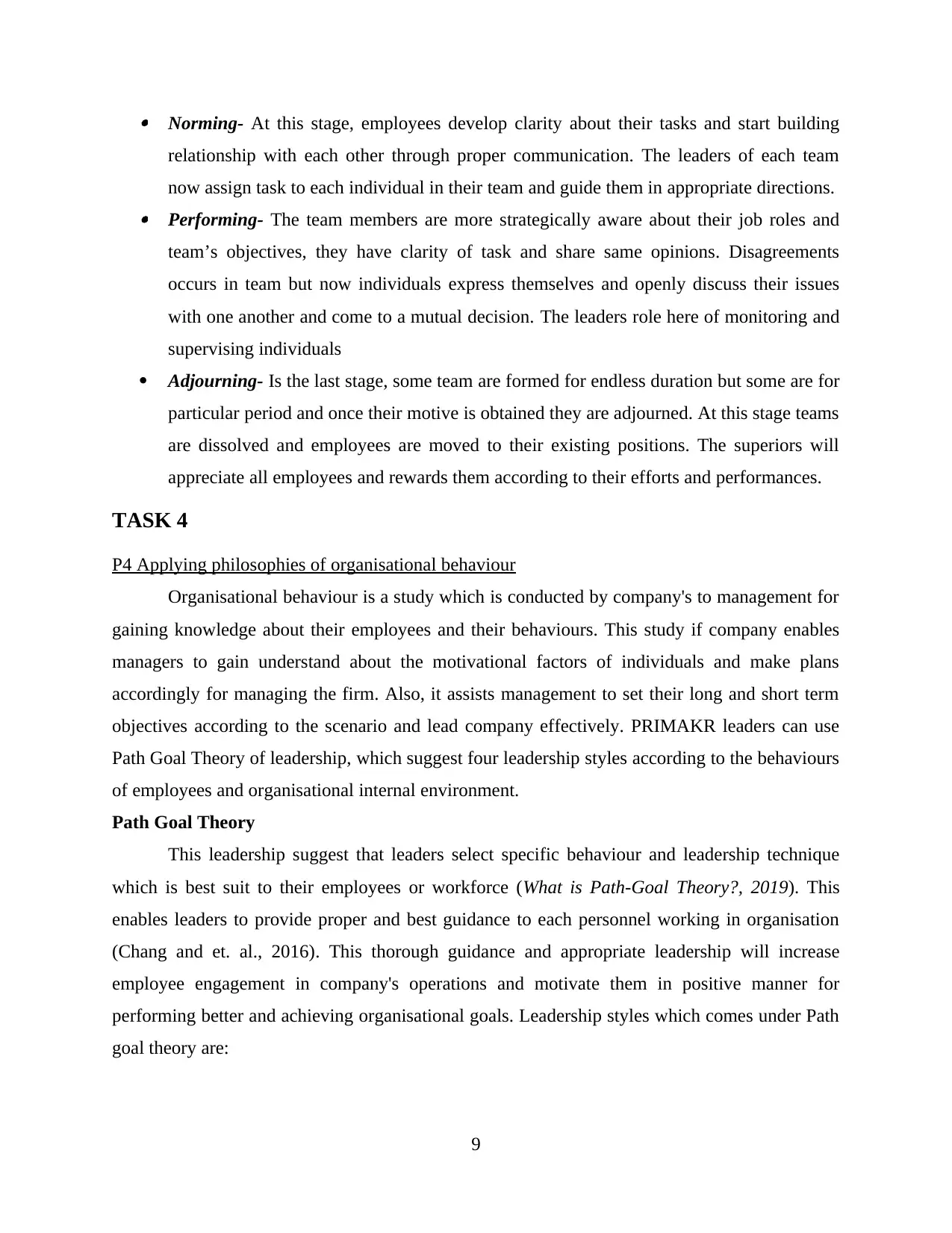
Norming- At this stage, employees develop clarity about their tasks and start building
relationship with each other through proper communication. The leaders of each team
now assign task to each individual in their team and guide them in appropriate directions. Performing- The team members are more strategically aware about their job roles and
team’s objectives, they have clarity of task and share same opinions. Disagreements
occurs in team but now individuals express themselves and openly discuss their issues
with one another and come to a mutual decision. The leaders role here of monitoring and
supervising individuals
Adjourning- Is the last stage, some team are formed for endless duration but some are for
particular period and once their motive is obtained they are adjourned. At this stage teams
are dissolved and employees are moved to their existing positions. The superiors will
appreciate all employees and rewards them according to their efforts and performances.
TASK 4
P4 Applying philosophies of organisational behaviour
Organisational behaviour is a study which is conducted by company's to management for
gaining knowledge about their employees and their behaviours. This study if company enables
managers to gain understand about the motivational factors of individuals and make plans
accordingly for managing the firm. Also, it assists management to set their long and short term
objectives according to the scenario and lead company effectively. PRIMAKR leaders can use
Path Goal Theory of leadership, which suggest four leadership styles according to the behaviours
of employees and organisational internal environment.
Path Goal Theory
This leadership suggest that leaders select specific behaviour and leadership technique
which is best suit to their employees or workforce (What is Path-Goal Theory?, 2019). This
enables leaders to provide proper and best guidance to each personnel working in organisation
(Chang and et. al., 2016). This thorough guidance and appropriate leadership will increase
employee engagement in company's operations and motivate them in positive manner for
performing better and achieving organisational goals. Leadership styles which comes under Path
goal theory are:
9
relationship with each other through proper communication. The leaders of each team
now assign task to each individual in their team and guide them in appropriate directions. Performing- The team members are more strategically aware about their job roles and
team’s objectives, they have clarity of task and share same opinions. Disagreements
occurs in team but now individuals express themselves and openly discuss their issues
with one another and come to a mutual decision. The leaders role here of monitoring and
supervising individuals
Adjourning- Is the last stage, some team are formed for endless duration but some are for
particular period and once their motive is obtained they are adjourned. At this stage teams
are dissolved and employees are moved to their existing positions. The superiors will
appreciate all employees and rewards them according to their efforts and performances.
TASK 4
P4 Applying philosophies of organisational behaviour
Organisational behaviour is a study which is conducted by company's to management for
gaining knowledge about their employees and their behaviours. This study if company enables
managers to gain understand about the motivational factors of individuals and make plans
accordingly for managing the firm. Also, it assists management to set their long and short term
objectives according to the scenario and lead company effectively. PRIMAKR leaders can use
Path Goal Theory of leadership, which suggest four leadership styles according to the behaviours
of employees and organisational internal environment.
Path Goal Theory
This leadership suggest that leaders select specific behaviour and leadership technique
which is best suit to their employees or workforce (What is Path-Goal Theory?, 2019). This
enables leaders to provide proper and best guidance to each personnel working in organisation
(Chang and et. al., 2016). This thorough guidance and appropriate leadership will increase
employee engagement in company's operations and motivate them in positive manner for
performing better and achieving organisational goals. Leadership styles which comes under Path
goal theory are:
9
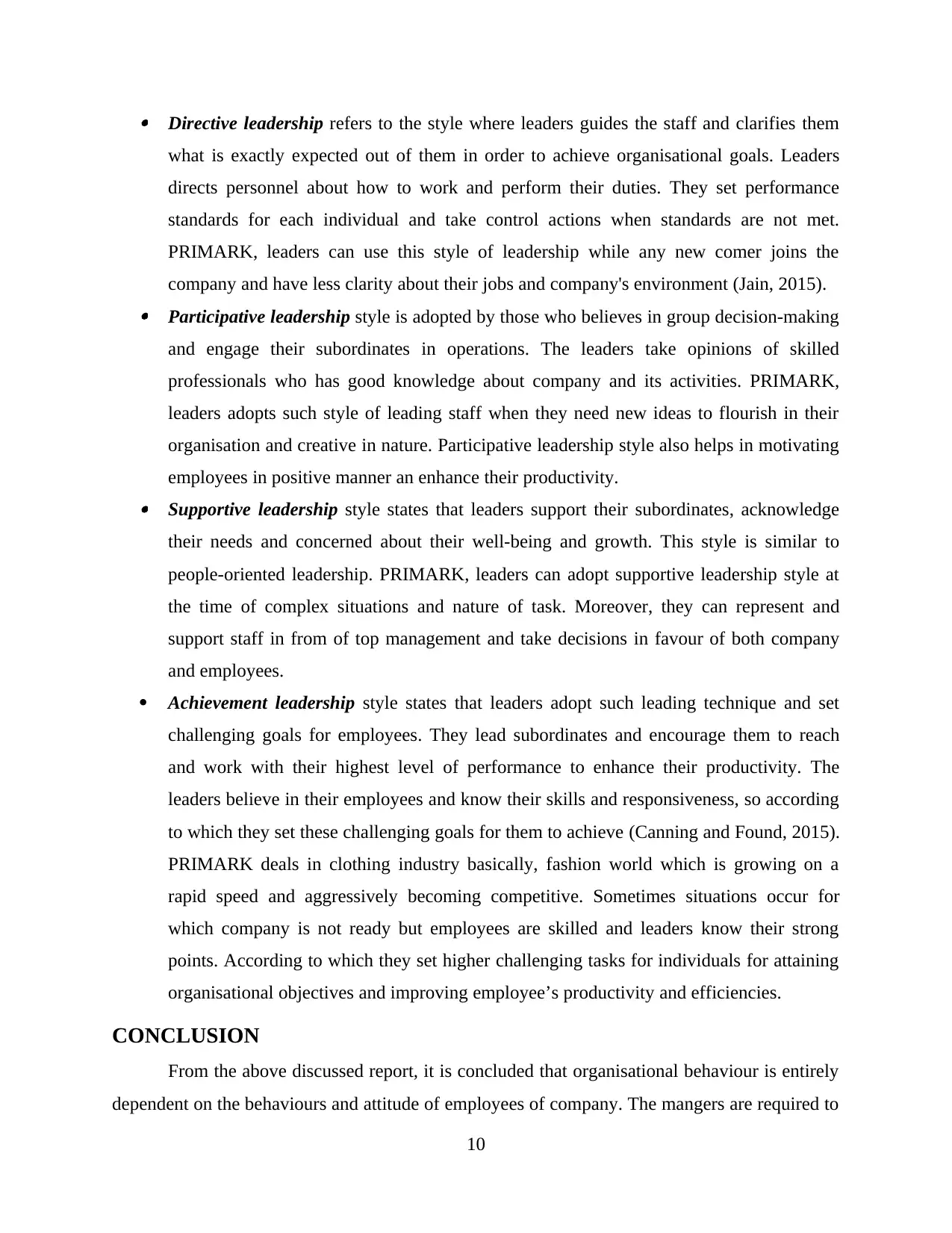
Directive leadership refers to the style where leaders guides the staff and clarifies them
what is exactly expected out of them in order to achieve organisational goals. Leaders
directs personnel about how to work and perform their duties. They set performance
standards for each individual and take control actions when standards are not met.
PRIMARK, leaders can use this style of leadership while any new comer joins the
company and have less clarity about their jobs and company's environment (Jain, 2015). Participative leadership style is adopted by those who believes in group decision-making
and engage their subordinates in operations. The leaders take opinions of skilled
professionals who has good knowledge about company and its activities. PRIMARK,
leaders adopts such style of leading staff when they need new ideas to flourish in their
organisation and creative in nature. Participative leadership style also helps in motivating
employees in positive manner an enhance their productivity. Supportive leadership style states that leaders support their subordinates, acknowledge
their needs and concerned about their well-being and growth. This style is similar to
people-oriented leadership. PRIMARK, leaders can adopt supportive leadership style at
the time of complex situations and nature of task. Moreover, they can represent and
support staff in from of top management and take decisions in favour of both company
and employees.
Achievement leadership style states that leaders adopt such leading technique and set
challenging goals for employees. They lead subordinates and encourage them to reach
and work with their highest level of performance to enhance their productivity. The
leaders believe in their employees and know their skills and responsiveness, so according
to which they set these challenging goals for them to achieve (Canning and Found, 2015).
PRIMARK deals in clothing industry basically, fashion world which is growing on a
rapid speed and aggressively becoming competitive. Sometimes situations occur for
which company is not ready but employees are skilled and leaders know their strong
points. According to which they set higher challenging tasks for individuals for attaining
organisational objectives and improving employee’s productivity and efficiencies.
CONCLUSION
From the above discussed report, it is concluded that organisational behaviour is entirely
dependent on the behaviours and attitude of employees of company. The mangers are required to
10
what is exactly expected out of them in order to achieve organisational goals. Leaders
directs personnel about how to work and perform their duties. They set performance
standards for each individual and take control actions when standards are not met.
PRIMARK, leaders can use this style of leadership while any new comer joins the
company and have less clarity about their jobs and company's environment (Jain, 2015). Participative leadership style is adopted by those who believes in group decision-making
and engage their subordinates in operations. The leaders take opinions of skilled
professionals who has good knowledge about company and its activities. PRIMARK,
leaders adopts such style of leading staff when they need new ideas to flourish in their
organisation and creative in nature. Participative leadership style also helps in motivating
employees in positive manner an enhance their productivity. Supportive leadership style states that leaders support their subordinates, acknowledge
their needs and concerned about their well-being and growth. This style is similar to
people-oriented leadership. PRIMARK, leaders can adopt supportive leadership style at
the time of complex situations and nature of task. Moreover, they can represent and
support staff in from of top management and take decisions in favour of both company
and employees.
Achievement leadership style states that leaders adopt such leading technique and set
challenging goals for employees. They lead subordinates and encourage them to reach
and work with their highest level of performance to enhance their productivity. The
leaders believe in their employees and know their skills and responsiveness, so according
to which they set these challenging goals for them to achieve (Canning and Found, 2015).
PRIMARK deals in clothing industry basically, fashion world which is growing on a
rapid speed and aggressively becoming competitive. Sometimes situations occur for
which company is not ready but employees are skilled and leaders know their strong
points. According to which they set higher challenging tasks for individuals for attaining
organisational objectives and improving employee’s productivity and efficiencies.
CONCLUSION
From the above discussed report, it is concluded that organisational behaviour is entirely
dependent on the behaviours and attitude of employees of company. The mangers are required to
10
⊘ This is a preview!⊘
Do you want full access?
Subscribe today to unlock all pages.

Trusted by 1+ million students worldwide
1 out of 15
Related Documents
Your All-in-One AI-Powered Toolkit for Academic Success.
+13062052269
info@desklib.com
Available 24*7 on WhatsApp / Email
![[object Object]](/_next/static/media/star-bottom.7253800d.svg)
Unlock your academic potential
Copyright © 2020–2025 A2Z Services. All Rights Reserved. Developed and managed by ZUCOL.





